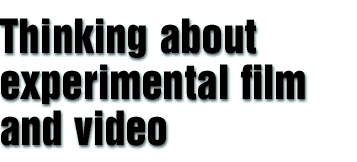|
 |
||
|
A. L. Rees' recent book on the history of experimental film and video is one of the rare attempts to get to grips with a intriguing aspect of cinema. Interview by Mel Taylor |
Mel Taylor: What made you decide to use the term "experimental" film and video for the title of your book?
A. L. Rees: There is no good word to describe it. In the book I listed all the various names I could think of that people have given to this sector, and they can all only be uttered with various degrees of embarrassment. The term avant-garde has kind of come back through media fashion and cultural changes, but only a short while ago.
I used the term experimental because I think it's got a long and continuous history of usage. It's currently around, and for me it had connotations of work that was open-ended and challenged fixed boundaries between ideas and art forms. Generally it suggests that the film or video maker is looking in those new directions that the term avant-garde also brings with it.
MT: Is there currently anything that can be described as experimental or avant-garde within the film, video or digital media sectors?
ALR: I think that it comes from two directions really. From film and video makers who, whether they're aware of it or not, because of the conditions in which they begin making work, usually in the art colleges, are picking up on a kind of tradition. Roughly they are the artists who keep going the London Film Makers' Co-op (LFMC) and London Electronic Arts (LEA) tradition that has been current in this country for about thirty years.
There is another group that emerged independently from that tradition, which we call the young British artists (yBa) movement. They have similar art school origins, but not necessarily specifically in film. For some of these film is a primary medium - particularly Gillian Wearing, Sam Taylor-Wood and Tacita Dean. For others film or video is just a part of their practice, but it intersects with either the classic artists' cinema, through its range of internal references - to Surrealism, etc. - or it does so in the gallery strategies it adopts to show work - projections, installations, etc.
Another sector which fused with the artists sector from the 1980s is the advanced wing of the commercial sector - rock promos, stings, the music side of it.
MT: In the book you document the history of experimental film from its earliest beginnings to the present day. Do you think that historical art and film movements have an influence on contemporary makers?
ALR: It was written as a kind of short guide through that history. I called it 'A' history rather than 'The' history, trying to make the scope of the book clear with that one word.
Of course, one can never be sure of anything. Some people discover where they are as artists and makers by the process of looking at work, screenings, and recognising shared interests across a very long period of time. It might be to do with subject matter, but more likely it is to do with form: shapes, scale, manipulation of time, and they might find their ancestors within the Dada movement, Cubism, Surrealism, or anything else.
The other way is that, as perhaps in all art forms, there is a limited number of problems which people keep returning to and trying to re-investigate in different ways. Rather than discovering something absolutely new, what we are often doing is a process of rediscovering. For example: what the world looks like, and how you can order that; issues of light, time and movement. Then you find, in hindsight, similar or related work going back a long time. Most of Harold Bloom's writings were devoted to the anxiety of influence. Some artists will happily admit to what they have seen and where they saw it, and for others that is not the case...
Can you give any specific examples of direct influence?...
What is it that makes these works experimental? What about the role or influence of new technologies upon the experimental sector?...
Can artists really make an intervention through television?...
Many of the young British artists use film and video as just "another medium". Given that the LFMC and LEA have recently merged to form the Lux and have taken on digital media, does that mark the start of a "media meltdown" and the end of medium specificity?...
What about film? Will it survive the digital transformation?...
Is this any more likely to enable artists to influence mainstream film culture? In the book you discuss some of the difficulties encountered by Derek Jarman and Peter Greenaway...
Finally then, what about artists who make the cross-over into the mainstream and particularly feature films?...
Mel Taylor
A. L. Rees is a Senior Research Fellow at the Royal College of Art. His book, A History of Experimental Film and Video, was recently published by the BFI
Full article published in Filmwaves - Issue 8, Summer 1999. Subscribe now!
